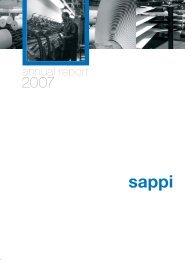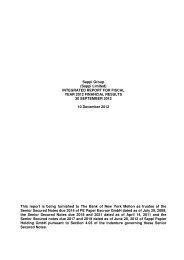2008 Annual report - Sappi
2008 Annual report - Sappi
2008 Annual report - Sappi
Create successful ePaper yourself
Turn your PDF publications into a flip-book with our unique Google optimized e-Paper software.
sappi //<br />
Goodwill is tested for impairment based on an allocation to one<br />
or more cash-generating units (CGUs) in which the synergies<br />
from the business combinations are expected. Each CGU<br />
containing goodwill is tested annually for impairment. An<br />
impairment loss is recognised whenever the carrying amount of<br />
an asset or its CGU exceeds its recoverable amount.<br />
Impairment losses recognised in respect of CGUs are allocated<br />
first to reduce the carrying amount of any goodwill allocated<br />
to a CGU and then to reduce the carrying amount of the other<br />
assets in the CGU on a pro-rata basis. Impairment losses relating<br />
to goodwill are not reversed.<br />
Critical areas of judgement and the use of estimates involving<br />
goodwill are included in section 2.3 of the accounting policies.<br />
2.2.3 Environmental expenditures and liabilities<br />
Environmental expenditure that pertains to current operations<br />
or relates to future revenues are expensed or capitalised,<br />
consistent with the company’s capitalisation policy. Expenditures<br />
that result from the remediation of an existing condition caused<br />
by past operations, and do not contribute to current or future<br />
revenues, are recognised in profit and loss for the period.<br />
Environmental accruals are recorded based on current inter -<br />
pretation of environmental laws and regulations. Amounts<br />
accrued do not include third-party recoveries. All available<br />
information is considered including the results of remedial<br />
investigation/feasibility studies (RI/FS). In evaluating any disposal<br />
site environmental exposure, an assessment is made of the<br />
company’s potential share of the remediation costs by reference<br />
to the known or estimated volume of the company’s waste that<br />
was sent to the site and the range of costs to treat similar waste<br />
at other sites if a RI/FS is not available.<br />
2.2.4 Financial instruments<br />
(i) Initial recognition<br />
Financial instruments are recognised on the balance sheet<br />
when the group becomes a party to the contractual provisions<br />
of a financial instrument. All purchases of financial assets that<br />
require delivery within the time frame established by regulation<br />
or market convention (’regular way’ purchases) are recognised<br />
at transaction date.<br />
(ii) Initial measurement<br />
All financial instruments are initially recognised at fair value plus<br />
transaction costs that are incremental to the group and directly<br />
attributable to the acquisition or issue of the financial asset or<br />
financial liability except for those classified as ’fair value through<br />
profit and loss’.<br />
Financial instruments carried at fair value through profit and loss<br />
are measured at fair value on transaction date. All transaction<br />
costs are immediately written off in the income statement.<br />
(iii) Subsequent measurement<br />
Subsequent to initial measurement, financial instruments are<br />
either measured at fair value or amortised cost, depending on<br />
their classification:<br />
• Financial assets and financial liabilities at fair value<br />
through profit or loss<br />
Financial instruments at fair value through profit or loss<br />
consist of items classified as held for trading. The group has not<br />
designated any financial instruments as at fair value through<br />
profit or loss.<br />
• Non-trading financial liabilities<br />
All financial liabilities, other than those at fair value through profit<br />
or loss, are classified as non-trading financial liabilities and are<br />
measured at amortised cost.<br />
• Held-to-maturity financial assets<br />
Held-to-maturity financial assets are measured at amortised<br />
cost, with interest income recognised in profit and loss for<br />
the period.<br />
The group does not presently have any held to maturity financial<br />
assets.<br />
• Loans and receivables<br />
Loans and receivables are carried at amortised cost, with<br />
interest revenue recognised in profit and loss for the period. The<br />
majority of the group’s receivables are included in the loans and<br />
receivables category.<br />
• Available-for-sale financial assets<br />
Available-for-sale financial assets are measured at fair value,<br />
with any gains and losses recognised directly in equity along<br />
with the associated deferred taxation. Any foreign currency<br />
translation gains or losses or interest revenue, measured on an<br />
effective-yield basis, are removed from equity to the income<br />
statement on debt instruments when they arise.<br />
(iv) Embedded derivatives<br />
Certain derivatives embedded in financial and host contracts,<br />
are treated as separate derivatives and recognised on a<br />
standalone basis, when their risks and characteristics are not<br />
closely related to those of the host contract and the host<br />
contract is not carried at fair value, with unrealised gains and<br />
losses <strong>report</strong>ed in profit or loss.<br />
// <strong>2008</strong> <strong>Annual</strong> <strong>report</strong><br />
87
















